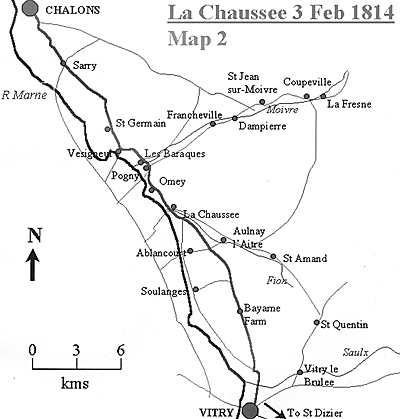Cavalry Combat at La Chaussee
3rd February 1814
The Skirmish at Aulnay L’aître
by Andrew Field, UK
| |
At 2pm on the 2nd, the French XI Corps and II Cavalry Corps (Exelmans) were pushing along the road to Vitry whilst the V Corps and III Cavalry Corps (Arrighi) were at La Chaussée. The snow had been falling in large flakes since the morning and this had hidden the French march from the Prussian vedettes that were posted in front of the village of Saint Amand. A French cavalry patrol from the Carabiniers was sent forward to the village of Aulnay l’Aître when a sudden break in the snow revealed a large force of Prussian cavalry on the far side of the village. The Prussians sent 60 men to attack the French patrol but attacked in their turn by French supports, they withdrew back across the River Fion that separated the two forces. Because of the poor visibility, both sides were wary of committing themselves to a general attack. Macdonald was annoyed by this lack of adventure as he wrote to Berthier that evening: “they lost time in useless dispositions, despite my formal order to push on towards Vitry”. [1]
Macdonald’s advance on Vitry had been halted by the lightest of contacts and he was still not sure what lay beyond the Prussian outposts, whilst York now had a fairly clear idea on where the lead French forces were. The reactions of the two opposing commanders to this unremarkable skirmish were to have a significant impact on the events of the following day.
That evening, Macdonald ordered Exelmans to put his light cavalry at Aulnay, Ablancourt and in front of La Chaussée and his heavy cavalry at Omey. Molitor was to put a battalion at Aulnay, another before La Chaussée and the remainder of his division into the village itself. Brayer was to put his division behind Aulnay while Sebastiani was to occupy Omey and Pogny. Arrighi was to echelon himself from Sarry to Pogny with one cavalry division covering the left from Francheville and Dampierre. His baggage was sent back to Châlons and the reserve artillery to Vésigneul and Saint-Germain. The Marshal’s report ended prophetically; “It is thus that we shall pass the night and from first thing in the morning will attack with more determination if we are not anticipated”. [2]
By 7pm all was calm again.
Little did Macdonald know that he had missed a golden opportunity to defeat York’s corps, even though it was considerably stronger than his own. At the moment the outposts of the two forces met, the Prussian corps was spread out as it tried to reconcile two possible missions. On one hand it needed to gather information on the French advance and to be able to meet it, whilst on the other York wanted to keep open the option of an attack on Vitry. A little more determination on the part of Macdonald and his cavalry commanders could have struck a telling blow as their forces were concentrated and the Prussians were not. However, this temporary advantage had now passed and the consequences were to be serious.
In his orders of the evening of the 2nd, Macdonald clearly understood the dangers that threatened him, even if he hoped to attack himself the next day. He advised his troops to patrol frequently and be alert, ending: “Before first light, all the troops are to be under arms, the advance guard mounted, the artillery ready to be put in battery”. [3]
However, despite his declared intention to attack, he had spread one of his cavalry corps out into what was effectively a defence of a river line. He had also sent the balk of his artillery to a position where it may have been safe but would not be able to influence events early the next day. By the evening of the 2nd, York’s cavalry were now concentrated as follows: Henckel at Aulnay l’Aître, von Jürgass at Saint-Amand and Katzler at Saint Quentin. Thanks to the interrogation of prisoners and deserters, the skirmish at Aulnay had sufficed momentarily to divert York’s attention away from Vitry and on to Macdonald. In order to be absolutely clear on the situation towards La Chaussée, the Prussian general sent there an officer from one of his Brigade headquarters, Major von Schutz.
On the basis of the information that this officer collected he was now clear that he was facing Macdonald’s small corps. He wrote to General Schwarzenberg, the allied commander in chief: “If he does not retire from La Chaussée during the night I shall attack him there tomorrow morning…until I have thrown him back from La Chaussée on Châlons.” [4]
The attack was to be by the corps cavalry of Generals von Jürgass and Katzler, and the detachment of Col Henck- el, while the 1st Corps infantry, with the exception of Pirch II’s Brigade, concentrated before Vitry-le-Brulée where it could move either to the cavalry’s support, or against Vitry.
Cavalry Combat at La Chaussee 3rd February 1814
Cavalry Combat at La Chaussee Part 2: 3rd February 1814 by Andrew Field, UK
|
